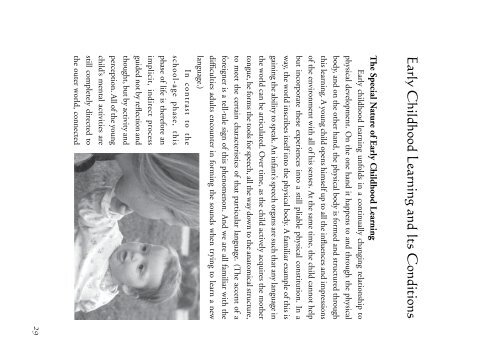Developmental Signatures - Waldorf Research Institute
Developmental Signatures - Waldorf Research Institute
Developmental Signatures - Waldorf Research Institute
Create successful ePaper yourself
Turn your PDF publications into a flip-book with our unique Google optimized e-Paper software.
The Special Nature of Early Childhood Learning<br />
Early childhood learning unfolds in a continually changing relationship to<br />
physical development. On the one hand it happens to and through the physical<br />
body, and on the other hand, the physical body is formed and structured through<br />
this learning. A young child opens himself up to all the influences and impressions<br />
of the environment with all of his senses. At the same time, the child cannot help<br />
but incorporate these experiences into a still pliable physical constitution. In a<br />
way, the world inscribes itself into the physical body. A familiar example of this is<br />
gaining the ability to speak. An infant’s speech organs are such that any language in<br />
the world can be articulated. Over time, as the child actively acquires the mother<br />
tongue, he forms the tools for speech, all the way down to the anatomical structure,<br />
to meet the certain characteristics of that particular language. (The accent of a<br />
foreigner is a tell-tale sign of this phenomenon. And we are all familiar with the<br />
difficulties adults encounter in forming the sounds when trying to learn a new<br />
language.)<br />
In contrast to the<br />
school-age phase, this<br />
phase of life is therefore an<br />
implicit, indirect process<br />
guided not by reflection and<br />
thought, but by activity and<br />
perception. All of the young<br />
child’s mental activities are<br />
still completely directed to<br />
the outer world, connected
















